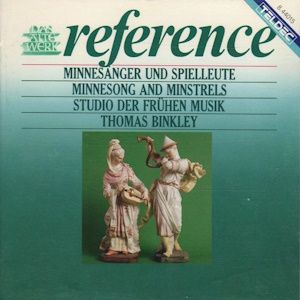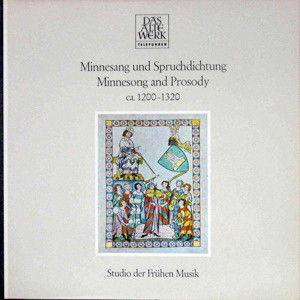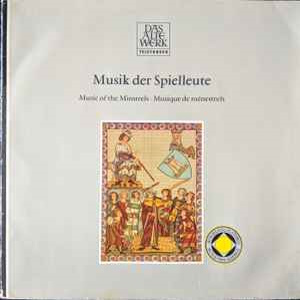 |
| 1 CD -
8.44015 ZS - (c) 1988 |
 |
1 LP -
SAWT 9487-A - (p) 1966 *
|
 |
1 LP -
6.41928 AW - (p) 1975 **
|
|
MINNESANGER UND SPIELLEUTE
|
|
|
|
|
|
|
|
|
|
| Walther von der
VOGELWEIDE (ca. 1170-1230) |
Mir hat her
Gerhart Atze ein pfert - Baß,
Flöte, Schalmei, Harfe, Rebec und
Schlaginstrumente
|
* |
3' 50" |
1 |
A1
|
|
Under der
linden an der heide -
Mezzosopran und Psalterium |
* |
3' 17" |
2 |
A2
|
|
Nu alrest lebe
ich mir werde (Palästinalied)
- Baß, Flöte, Schalmei, Harfe,
Laute, Rebec und Schlaginstrumente |
* |
4' 42" |
3 |
A3
|
| Neidhart von REUENTAL
(ca, 1190-1240) |
Meie,
din liehter schin - Tenor und
Laute |
* |
3' 50" |
4 |
A4
|
|
Blozen wir den
anger ligen sahen -
Mezzosopran, Zitôle (Cister) und
Rebec |
* |
4' 15" |
5 |
A5
|
|
Fürste
Friedrich (Owê dirre nôt) -
Tenor, Flöte, Schalmei, Rebec |
* |
1' 18" |
6 |
A6
|
|
Meienzit
(Pseudo-Neidhart) - Tenor und Harfe |
* |
4' 41" |
7 |
A7
|
| ANONYMUS
(um 1300) |
Chançonetta
Tedescha I (Instrumentalstück)
- Flöte, Schalmei, Harfe, Laute,
Rebec und Schlaginstrumente
|
* |
1' 45" |
8 |
B1 |
| Reinmar
von BRENNENBERG (vor 1276)
|
Wol
mich des tages do mir alrerst ist
worden kunt - Tenor, Flöte und
Laute |
* |
6' 41" |
9 |
B2 |
| ANONYMUS
(um 1300) |
Chançonetta
Tedescha II
(Instrumentalstück) - Flöte,
Schalmei, Harfe, Laute, Rebec und
Schlaginstrumente |
* |
1' 07" |
10 |
B3 |
| DER
UNVERZAGTE (um 1280) |
Der kuninic
Rodolp minnet got - Baß,
Schalmei und Rebec |
* |
5' 24" |
11 |
B4 |
| Frauenlob,
Heinrich von MEISSEN (1318)
|
Ez waent ein
narrenwise - Baß, Flöte,
Schalmei, Harfe und Fidel |
* |
4' 22" |
12 |
B5 |
| WIZLAW
(um 1300) |
Ich warne dich,
vil junger man, gezarte -
Mezzospran |
* |
1' 25" |
13 |
B6 |
|
Loibere risen
- Tenor, Fidel und Psalterium |
* |
2' 55" |
14 |
B7 |
| ANONYMUS |
La Tierche
Estampie Roial (Paris, Bibl.
Nat. f. fr. 844) - Schalmei, 2
Lauten, Organetto, Fidel, Lira |
** |
4' 30" |
15 |
B1 |
|
Estampie
(Robertsbridge) - (London, Brit.
Mus. add. 28 550) - 2 Fideln |
** |
6' 00" |
16 |
B2 |
|
Chose Tassin
(Montpellier, Bibl. de la Favulté
de Médicine, ms. H. 196) - Laute,
Organetto, Citole, 2 Fideln,
Trommel |
** |
4' 45" |
17 |
B3 |
|
Ductia
(London, Brit. Mus. Harlianus 978)
- Mezzosopran, Tenor, 3 Dulziane,
Trommel |
** |
2' 45" |
18 |
B4 |
|
Estampie
(Oxford, Bod. Lib. Douce 139) -
Laute, Gittern, Fidel,
Maultrommel, Lira, Organetto,
Clocken, Schellentrommel |
** |
4' 55" |
19 |
B5 |
|
|
|
|
|
Minnesang und
Spruchdichtung *
|
Musik der Spilleute **
|
|
|
|
|
| STUDIO
DER FRÜHEN MUSIK |
STUDIO
DER FRÜHEN MUSIK
|
|
| -
Andrea von Ramm, Mezzosopran |
-
Andrea von Ramm, Mezzosopran,
Organetto (Portativ), Clöckchen
|
|
| -
Willard Cobb, Tenor |
-
Richard Levitt, Tenor,
Trommel, Tambour
|
|
| -
Sterling Jones, Rebec,
Fidel |
-
Thomas Binkley, Laute,
Schellentrommel, Dulzian
|
|
| -
Thomas Binkley, Lauten,
Zitôle, Psalterium |
-
Sterling Jones, Vielle
(Fidel), Rebec, Dulzian,
Maultrommel
|
|
| Weitere
Mitwirkende: |
Weitere
Mitwirkende:
|
|
| -
Max van Egmond, Baß |
-
Paul O'Dette, Gittern,
Laute, Dulzian, Citole |
|
| -
Leonore Wehrung, Flöte |
-
Alice Robbins, Lyra,
Vielle (Fidel), Trommel
|
|
-
Caroline Butcher, Schalmei
|
-
Paul Hailperin, Schalmei |
|
| -
Helga Storck, Harfe |
Thomas
BINKLEY, Übertragung und
Bearbeitung |
|
| -
Horst Huber, Schlaginstrumente |
|
|
| Thomas
BINKLEY, Übertragung und
Bearbeitung |
|
|
| Burghart
Wachinger, Revision der
Texte und Übersetzungen |
|
|
|
|
|
|
Luogo
e data di registrazione |
|
- |
|
|
Registrazione:
live / studio |
|
studio |
|
|
Producer /
Engineer |
|
- |
|
|
Prima Edizione
LP |
|
Telefunken
- SAWT 9487-A - (1 LP) - durata
50' 09" - (p) 1966 - Analogico *
Telefunken - 6.41928 AW - (1 LP) -
durata 22' 46" - (p) 1975 -
Analogico **
|
|
|
Edizione
"Reference" CD
|
|
Tedec
- 8.44015 ZS - (1 CD) - LC 3706 -
durata 74' 08" - (c) 1988 - AAD |
|
|
Cover |
|
"Chinesenpaar
m. Serpent u. Drehleier",
Porzellan. Höchst um 1763/67.
Museum für Kunst und Gewerbe,
Hamburg.
|
|
|
Note |
|
This
Compact Disc is the miscellany of
two Telefunken publications: one
in its entirety (SAWT 9487-A) and
one partial to side 2 only
(6.41928 AW).
|
|
|
|
|
Twelve
songs selected primarely
from the musical
standpoint, clearly
cannot illustrate
adequately the abundance
od Middle-High German
lyric. Newertheless,
this recording presents
a fair impression of the
literaly aspect of the
German art-song in the
thirteenth century.
The selection comprises
texts from different
areas pf language and
literature: Walther,
Neidhart and
Brennenberger are from
the Bavarian and
Austrian dialect areas,
Heinrich von Meißen is
from the central region,
whereas Wizlaw wrote in
the central dialect
while employing some
characteristics which
reveal his North German
origin.
The span of time covered
by this anthology ranges
from the golden age of
courtly poetry, roughly
1200 (from Walther von
der Vogelweide, who
crowned the short steep
ascent of the early
German art-song, and who
both hastened and
lamented the discruption
of the organic, seylized
concept of the world and
of courtly) up to its
deterioration around
1300, at which time
Frauenlob took a stand
against the imitation of
the traditional literary
style as continued by
most of his
contemporaries and
attempted through novel
speculation and a
mannered literary style
to form a "modern" lyric
tradition. In this
collection, several
types of Middle-High
German lyric are
surveyed; to be sure,
the point of emphasis
has been conditioned by
the availability of
sources. The largest and
best musical sources
contain for the most
part the so-called Spruchdichtung
of Neidhart and his
imitators. Spruchdichtung
is the name given to a
kind of sung poetry
composed by itinerant
professionals. Their
subjects include the
praise of God and Mary,
the praise of princes,
ethics, art theory,
political and personal
satire, and even
begging. Only rarely did
they express thoughs on
Minne, courtly
love, and when they did,
it was didactic, Minnesang
(song of courtly love)
is the term employed to
refer to the poetry
cultivated within the
courtly society, written
by noblemen and
highranking ministers.
The complexity of life
and the richness of art
tended to confuse the
social and thematic
differences between Spruchdichtung
and Minnesang.
Walther, Frauenlob and
Wizlaw all cultivated
both Minnesang
and Spruchdichtung,
Neidhart employed Spruch-motives
in Minnesang (e.
g. Fürste Friederich),
while Brennenberger
employed the same melody
for a Minnesang
in which he had composed
Spruchdichtung.
Within Minnesang
various forms can be
distinguished, of which
only the dawn song
(Tagelied) and the lay
(Leich) are absent from
this collection; they
must be reserved for
recording of their own.
A common form of Minnesang
written in the first
person and opening with
a description of the
season, is represented
here by two rather late
examples: "Meie din" and
"Loibere risen". The
background of both
songs, although
schematized and with the
problem removed, is the
French concept of
courtly love (caritas,
not amo),
German: bobe Minne,
for which Walther
desperately fought. Here
the woman was a married
lady of society, who
remained inaccessible to
her admirer; love was
exhausted in fruitless
hope, in "serving",
which even the
highest-ranking men took
upon themselves und
through which they
schieved an inner
nobility, and in
continual laments sang
to the enjoyment of the
company. Middle-High
German lyric reflected
requited love almost
solely in the dialogue
songs, usually in the
form of niedere
Minne ("Lowly
love", i. e. amo,
not caritas),
outside the courtly
society. Walther's
beautiful Under der
Linden reflects a
kind of love for which
the gates of courtly
poetry remained firmly
closed. In Neidhart's
ironical and drastic
songs, the longing of a
village beauty for the
knight, and the rivalry
between knight and
villager for the girl's
attention, become
amusing and softly
warning antitypes to the
finely mannered court.
Middle-High German songs
had several strophes. In
the case of the single
strophe of Wizlaw's "Ich
warne dich", the scribe
has left room for two
additionals strophes,
perhaps because he knew
that there were more
strophes or perhaps
because he just couldn't
imagine a song with but
one strophe. Therefore
the songs on this
recordings are complete
and uncus. The nature of
Spruchdichtung,
however, sometimes
requires cutting,
because we often have
many unrelated strophes
for one melody, without
any recognizable formal
or artistic unity. It is
likely that the poet
himself sang only this
or that strophe,
according to the
situation. Thus we have
selected six, out of
nine, strophes of
Unverzagten, three of
Brennenberger's
thirteen, and three of
Frauenlob's twelve.
There are altogether
twelve strophes of
Walther's Palestine Song
(Nu alrest...)
distributed among
several manuscripts. Of
these, some are
established, others were
possibly later
additions. Our version
contains the five
considered by Hugo Kuhn
to be authentic.
Similarly, only those
considered the oldest
strophes of "Meie din"
are sung. In one case a
single strophe, complete
in itself, and unrelated
to the other strophes,
is selected from a
longer song (Fürste
Friedrich).
Burghart
Wachinger
|
|